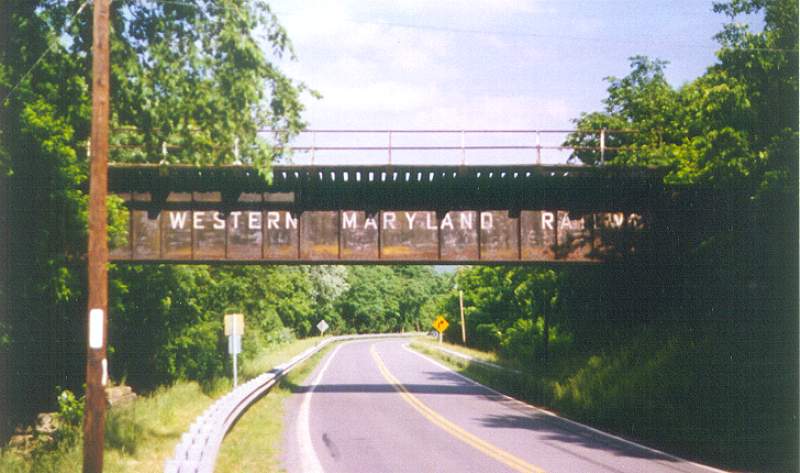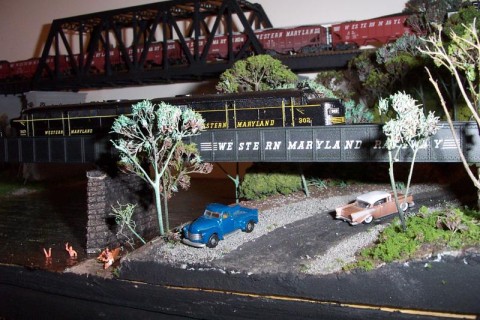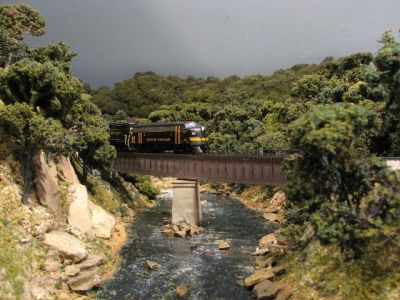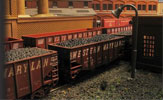

This overpass is a truncated version of the one at right. I plan to include a full version elsewhere on the layout. I used MicroScale decals from their N scale WM Hood Diesels set. The bridge is located at the east end of Luke, and the truck is on its way to the Westvaco warehouse.
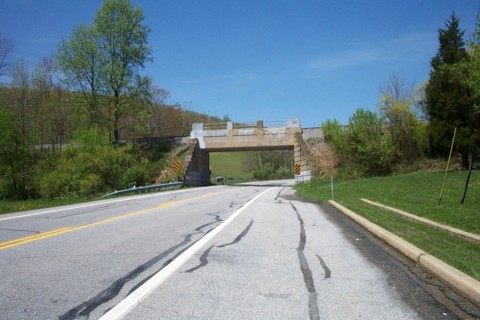
This example is still in service on the Maryland Midland at Sabillasville, Maryland. The state highway passes under the tracks at the apex of the WM's horse shoe curve between Thurmont and Highfield. The Midland hasn't taken advantage of the advertising space built into the bridge. In this 2003 view, only the faintest ghosts of WM speedlettering is visible.
Steel Bridges
Between Hagerstown and Cumberland, the WM crossed the Potomac River 10 times, (including the interchange at Cherry Run) each time on a significant steel bridge. Between Cumberland and Connellsville, the railroad's two largest bridges carried the line back and forth over the B&O main. Unfortunately, the layout lacks the space to model any of these significant structures, but I do have several locations that the Civil Engineering staff has had to work on.
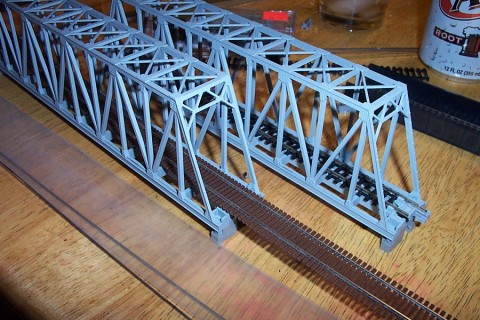
The most significant span on the layout is the bridge carrying the Thomas Sub toward Chaffee. It crosses the Potomac, plus the junction at MY. I used Kato Unitrak single track thru trusses for the job, but I had to get rid of the clunky gigantic track. I had to use a flat file to clean off the bumps that are molded in to hold the Unitrak in place. Plus, the good folks at Kato glue the track in, so this was a giant pain in the butt. It was well worth it, though. After weathering the bridges and installing ME bridge track, it looks like a million bucks. It's the current highlight scene on the layout.

This picture also gives you a little peek behind the curtain as to how I build my scenery.
This is an early picture of the next bridge to be completed on the N scale WM. This is a plate-girder deck bridge, with the track located on top of the girders. It's built from Micro Engineering 80' plate girders and ME c55 bridge track. As you can see, there's still a lot to do to finish this scene, but I'm looking forward to it being "ready for prime time."
The view below it right gives a good look at the bridge track. This particular bridge is comprised of three Atlas plate girder spans. The WM typically used deck style girder bridges (where the track sits on top of the girders, rather than in between them on a frame), but the low clearances created by my multi-layered construction dictated that these were necessary.
The key features that make ME Bridge Track such a Godsend are the big square ties that stretch well beyond the length of standard track ties, and the guard rails. ME supplies lengths of Code 40 rail with their bridge track for this purpose, and it really looks terrific. Below is another view of the same bridge looking from down river.
Again, the piers and abutments are scratch built from Evergreen stock.

Concrete Overpass
It was always easy to tell when you were in Western Maryland country. The railroad was proud of its reputation, and proud to put its name on just about anything associated with it. The bridges of the WM were probably the most visible landmarks to receive this treatment.
The civil engineers of the WM also used a variety of materials and methods to span everything from a drainage ditch to a 1,900 foot valley. Among my favorites are the concrete overpasses that could be found at a number of locations around the railroad. Although they were built a number of years before the Speedlettering paint scheme was adopted in 1954, the recessed panels in the sides of the bridge seemed made to order.
I scratch built the abutment and the bridge deck following the prototype photo below. The pier is also scratched out of Evergreen styrene to support the modified Kato truss bridge, too.
Abandoned in 1975, this bridge survived until a highway safety project took it out in 2004. I took this shot in 1989. The lettering on the bridge still looks pretty fresh.
This photo was made in 1989, 14 years after abandonment. The bridge is located near Paw Paw, West Virginia, but on the Maryland side of the river. This bridge stoicly hangs on to its steam era paint job.
On the N scale Western Maryland, I'm also keeping the railroad's name in the public eye...
Although I prefer speedlettering! The lettering here came from an HO scale caboose set by Champ. I pieced together the word "Railway" from the same set. The only letter you have to cheat is the "I". The plate girder bridge in the foreground is made up of three Kato spans, with the Unitrak removed and Micro Engineering Code 55 bridge track installed. The high through truss in the back is a Walthers kit with ME short spans approacing from both sides.
Looks like a little impromptu swim party is taking place. Those punks are oblivious to the roar of WM FA-2's 302 and 303 passing by.
The photo at left shows the twin spans of the Kato bridge from the unfinished side of the layout. The track below the bridge on the left is the Connellsville main. The unfinished river will continue to bend to the left toward Chaffee, and the Connellsville line will cross it before entering a tunnel and leaving the scene. The tracks on the far right are the mains from Cumberland.
The abutments and pier are construction of sheet and strip Evergreen styrene. If you haven't tried scratchbuilding anything before, bridge abutments are a good place to start. I plan to go back to weather the concrete to give it more of a realistic look.
The bridges were weathered by misting alternating sprays of black, grey and oxide red spray bombs.
Click Here to see how I built this scene...

As I get more of the layout completed, I'll add sections about more of the bridges. Stay tuned!
